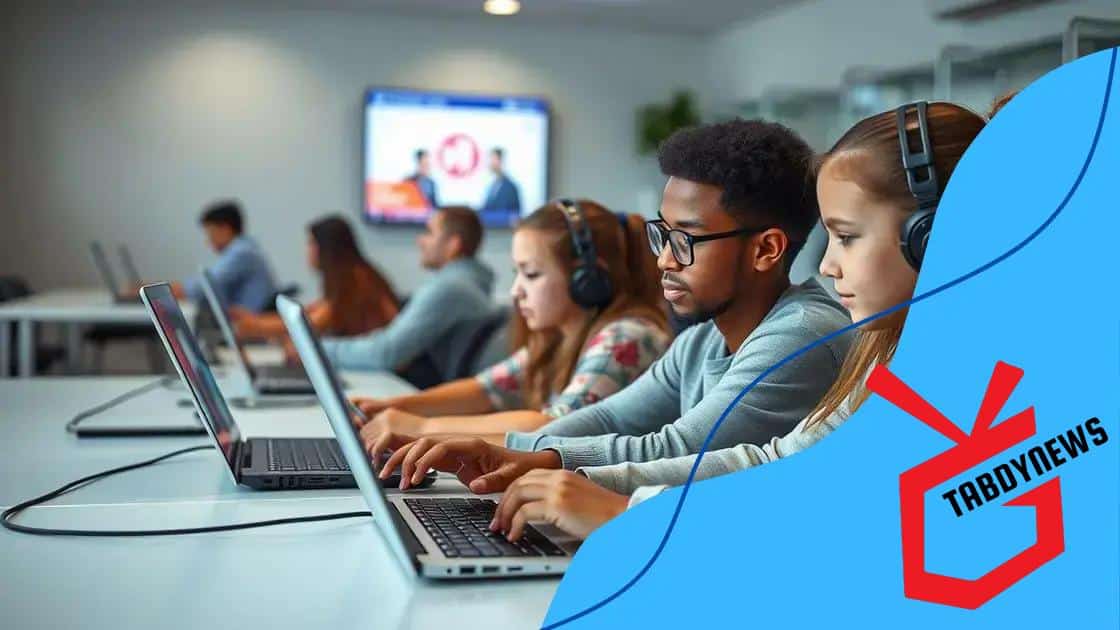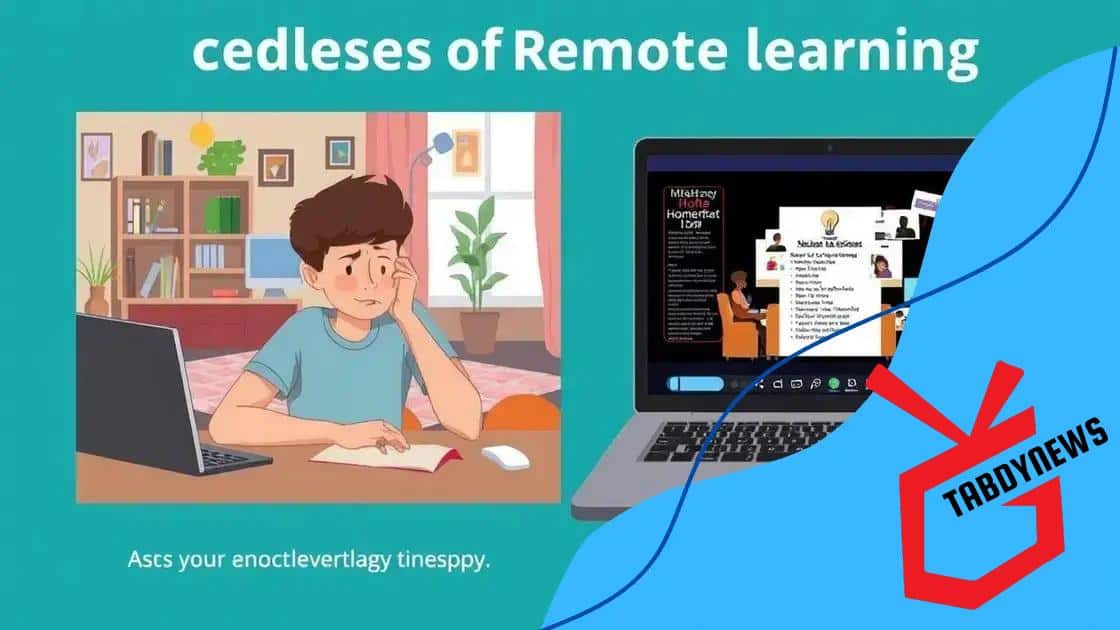Innovations in remote education technology transforming learning

Innovations in remote education technology, such as AI and virtual reality, enhance learning by personalizing experiences, increasing engagement, and making education more accessible for students worldwide.
Innovations in remote education technology are changing the landscape of learning. Have you ever wondered how these advances allow students to connect and learn from anywhere? Let’s dive in!
emerging tools in remote education
As remote education continues to grow, many new tools are emerging to support both teachers and students. These tools not only enhance learning but also make it more accessible. With the right technology, education becomes more engaging for everyone.
Innovative Platforms
Many platforms are now available that allow students to attend classes from home. For instance, tools like Zoom and Microsoft Teams provide virtual classrooms that let teachers interact with students in real-time. Features like breakout rooms and screen sharing make discussions much easier.
Interactive Learning Tools
Interactive learning tools encourage student participation. Programs like Kahoot! enable teachers to create quizzes that students can answer on their devices. This gamified approach makes learning fun and motivating.
- Video Conferencing – Essential for live classes.
- Learning Management Systems – Organize and track student progress.
- Collaboration Tools – Foster teamwork on projects.
In addition to these platforms, there are resources like Google Classroom, which streamline assignment sharing. Students can submit their work online, making it easier for teachers to manage and evaluate.
Accessibility Features
Emerging tools are also focusing on making education accessible for everyone. Features such as closed captioning and screen readers allow learners with disabilities to engage fully. This ensures that no student is left behind, making remote education more inclusive.
The use of educational apps is also on the rise. These apps can provide personalized learning experiences tailored to each student’s needs. For example, language learning apps allow students to practice at their own pace, adjusting to their progress.
As we look to the future, the integration of artificial intelligence into these tools is expected to enhance the learning experience even further. Tools that adapt to student performance will make education more effective. Ultimately, these emerging tools play a vital role in shaping the future of remote education.
benefits of virtual classrooms
Virtual classrooms offer a unique approach to learning that has transformed traditional educational methods. With the rise of remote education, these classrooms have become essential for students worldwide. They provide students the flexibility to learn from anywhere, which has become increasingly important in today’s fast-paced environment.
Flexibility and Accessibility
One of the main benefits of virtual classrooms is their flexibility. Students can learn at their own pace, accessing materials whenever they need them. This means that if a student struggles with a concept, they can revisit the material as many times as necessary without feeling rushed. In addition, virtual classrooms are accessible to students who may face challenges attending traditional schools due to geographical or health issues.
Enhanced Engagement
These online environments often include interactive features that keep students engaged. For example, many platforms allow real-time polls, quizzes, and discussions, making learning more interactive. As a result, students feel more connected to their peers and instructors, which can enhance their overall learning experience.
- Multimedia Resources – Use videos and animations to clarify complex concepts.
- Real-Time Communication – Instant messaging and video chats facilitate immediate feedback.
- Global Learning – Interact with students and teachers from around the world.
Moreover, virtual classrooms foster a sense of community among learners. Students can collaborate on projects easily through shared online tools, breaking down barriers that physical classrooms sometimes create. This collaboration helps develop crucial skills such as teamwork and communication.
As technology evolves, the benefits of virtual classrooms continue to expand. Integration of advanced tools allows teachers to track progress through analytics, which helps personalize lessons to fit individual student needs. This tailored approach ensures that every student can thrive, regardless of their current knowledge level.
The combination of flexibility, enhanced engagement, and community support makes virtual classrooms a powerful tool in modern education. As we move forward, the benefits will only grow, paving the way for an exciting future in remote learning.
challenges in remote learning

Remote learning presents many unique challenges that both students and educators face. As remote education becomes more prevalent, these obstacles must be addressed to ensure effective learning. While technology offers incredible opportunities, it can also lead to difficulties that hinder success.
Technology Issues
One major challenge in remote learning is the reliance on technology. Not all students have access to reliable internet or devices. This digital divide creates inequalities among learners, as some may struggle to participate fully. Additionally, technical issues can disrupt lessons, leaving students frustrated and disconnected.
Self-Motivation
Another significant challenge is the need for self-motivation. In traditional classroom settings, teachers can engage students directly. In virtual environments, however, students must be more proactive about their learning. This can be tough for some, especially younger learners who might need more encouragement to stay focused.
- Lack of Structure – Students may feel less motivated without a rigid daily schedule.
- Distractions at Home – Family members, pets, and other interruptions can make focusing difficult.
- Time Management – Balancing school with other responsibilities can overwhelm students.
Moreover, social interaction is limited in remote settings. Students often miss out on opportunities to connect with classmates and teachers. This lack of interaction can lead to feelings of isolation and impact their overall well-being. Forming friendships and collaborating on projects can be much harder without face-to-face contact.
Another concern is the difficulty in assessing student performance. Educators often rely on participation and engagement as indicators of understanding. In a virtual environment, these cues can be harder to read. This makes it challenging to gauge how well students grasp the material. Creatively adapting assessments to fit this new format is necessary for accurate evaluation.
Despite these challenges, it is essential to explore ways to improve remote learning experiences. Recognizing these hurdles can help teachers, students, and parents collaboratively find solutions. By embracing innovative approaches, the potential of remote education can be maximized.
how technology enhances engagement
Technology plays a crucial role in enhancing student engagement in remote learning environments. With the integration of various tools, teachers can create more interactive and dynamic experiences for students. This shift not only makes learning enjoyable but also fosters deeper understanding of the material.
Interactive Learning Tools
One way technology increases engagement is through interactive learning tools. Platforms like Kahoot! and Quizlet allow students to participate actively in quizzes and games. This gamification of education motivates students to learn while having fun. Engaging activities capture students’ attention and encourage participation.
Multimedia Resources
Another important aspect is the use of multimedia resources. Videos, animations, and infographics can illustrate complex concepts easily. When students can see and hear information, they are more likely to remember it. Dynamic content keeps them interested and involved in their own learning process.
- Live Polls – Instantly gather student feedback during lessons.
- Virtual Breakout Rooms – Enable small group discussions for collaborative learning.
- Interactive Whiteboards – Allow teachers to showcase ideas visually and engage students in real-time.
Moreover, technology facilitates communication between teachers and students. Tools like Slack or Google Classroom promote open dialogue, making it easy for students to ask questions or share ideas. This accessibility helps build a supportive learning environment where students feel valued and heard.
As technology continues to evolve, the possibilities for engagement grow. Innovations like virtual reality (VR) offer immersive experiences that transport students to different places or historical events. By simulating real-world scenarios, VR enhances understanding and makes lessons more memorable.
Ultimately, technology significantly enhances engagement in remote education. By incorporating various tools and resources, educators can create an interactive, inclusive, and stimulating learning experience for students, paving the way for lifelong learning.
the future of remote education technology
The future of remote education technology holds exciting possibilities as advancements continue to reshape how we learn. With each new innovation, education becomes more accessible and engaging for students around the world. These changes not only enhance learning experiences but also prepare students for a rapidly evolving digital landscape.
Artificial Intelligence Integration
One significant trend is the integration of artificial intelligence (AI) into educational platforms. AI can personalize learning experiences by adapting content to match individual student needs. For example, chatbots can provide instant feedback on assignments or answer questions outside class hours. This allows students to receive help whenever they need it, fostering a more interactive learning environment.
Increased Use of Virtual Reality
Another exciting development is the increased use of virtual reality (VR) in education. VR technology can create immersive learning experiences that bring subjects to life. Students can explore historical sites or conduct scientific experiments in a virtual environment, engaging them in ways that traditional classrooms cannot. This hands-on approach enhances understanding and retention of information.
- Collaborative Learning – Future tools will emphasize teamwork and project-based learning online.
- Data-Driven Insights – Educators will use data analytics to track student progress and improve teaching methods.
- Global Classrooms – Remote learning will connect students with peers around the globe, promoting cultural exchange.
Additionally, the advancement of learning management systems (LMS) will streamline the educational process. Users will benefit from advanced features that promote collaboration, ease of access to materials, and enhanced communication between students and teachers. As these systems evolve, they will become central hubs for academic resources and social interaction.
Upcoming trends also point towards greater emphasis on soft skills development. Employers increasingly seek candidates with skills such as critical thinking, communication, and teamwork. Educators will integrate these skills into online curricula, ensuring that students are prepared for the workforce.
As the landscape of remote education technology changes, staying adaptable is vital. Schools must embrace new tools and methodologies to keep pace with the demands of modern learners. The future promises an even more engaging and inclusive educational experience.
In conclusion, the future of remote education technology looks very promising. As innovations like AI and virtual reality continue to emerge, they will enhance the learning experience for students everywhere. While challenges do exist, such as access to technology and self-motivation, the opportunities for engaging and effective education are vast. By embracing these advancements, educators can create dynamic and inclusive learning environments that prepare students for success in a digital world. The shift towards technology-driven education will ultimately transform how we learn, making it more exciting and accessible than ever before.
\n\n
\n
FAQ – Frequently Asked Questions about Remote Education Technology
How does artificial intelligence enhance remote learning?
AI personalizes the learning experience by adapting content to fit individual student needs, providing instant feedback and support.
What role does virtual reality play in education?
Virtual reality creates immersive learning environments, allowing students to explore historical sites or conduct experiments in a virtual setting.
What are some challenges faced in remote education?
Challenges include technology accessibility, maintaining student motivation, and limited social interaction among peers.
How can technology improve student engagement?
Technology enhances engagement through interactive tools, multimedia resources, and increased communication between students and teachers.





